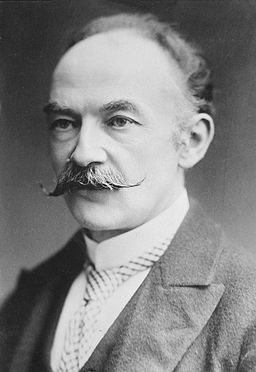Thomas Hardy (1840-1928), novelist and poet, was born on 2 June 1840, in Higher Bockhampton, Dorset. The eldest child of Thomas Hardy and Jemima Hand, Hardy had three younger siblings: Mary, Henry, and Katharine. Hardy learned to read at a very young age, and developed a fascination with the services he regular attended at Stinsford church. He also grew to love the music that accompanied church ritual. His father had once been a member of the Stinsford church musicians - the group Hardy later memorialised in Under the Greenwood Tree - and taught him to play the violin, with the pair occasionally performing together at local dance parties.
Whilst attending the church services, Hardy developed a fascination for a skull which formed part of the Grey family monument. He memorised the accompanying inscription (containing the name 'Angel', which he would later use in his novel Tess of the d'Urbervilles) so intently that he was still able to recite it well into old age.
Adulthood
Between the years of 1856-1862, Hardy worked as a trainee architect. He formed an important friendship with Horace Moule. Moule - eight years Hardy's senior and a Cambridge graduate - became Hardy's intellectual mentor. Horace Moule appears to have suffered from depression, and he committed suicide in 1873. Several of Hardy's poems are dedicated to him, and it is thought some of the characters in Hardy's fiction were likely to have been modeled on Moule.
It was in 1870 that Hardy first met Emma Gifford, his future wife. The meeting occurred whilst Hardy was working on an architectural trip in Cornwall; both Hardy's Cornish internship and the encounter with Emma seem to have inspired several of the characters and scenes in Hardy's second novel A Pair of Blue Eyes.
Hardy married Emma in 1874 and they moved to London for a short period, before returning to Dorset in 1875. The married couple moved into the Victorian villa 'Max Gate' in 1885, located just outside Dorchester. The house was designed by Hardy and built by his brother Henry.
Publications and Later Life
After the controversy sparked by the publication of Hardy's final novel Jude the Obscure (1895), Hardy ceased to write fiction, although in 1897, The Well-Beloved was published in amended book form (it was first published in serialised form in 1892, three years before Jude appeared). Hardy maintained that it was only through poetry that he could express his ideas, and in his later years, managed to write more than nine hundred poems on a diverse range of subjects. In 1898 his first collection of poems were published; entitled Wessex Poems and Other Verses, the poetry also contained various quirky illustrations drawn by Hardy.
Emma died on 27 November 1912, two years after Hardy was awarded the Order of Merit. At this point in time, husband and wife were estranged, both living separate lives at Max Gate. Using his depressing experience of matrimony as evidence, Hardy had written extensively on the problems with English marriage and inflexible divorce laws, describing the intense unhappiness they caused. However, Hardy found Emma's death incredibly affecting, and was filled with sadness and guilt. These feelings manifest themselves in Hardy's collection of love poems: Poems of 1912-1913, which he dedicated to Emma. The poems are eulogies which recall memories of the two together, and register Hardy's sense of grief and loss.
Hardy married Florence Dugdale in 1914. She had met Hardy several years earlier whilst he was married to Emma, and had soon become friends with the couple, working as Hardy's part-time secretary. She was reportedly incredibly hurt by the love poems Hardy wrote to Emma after her death.
On 11 January 1928, Hardy died at Max Gate. His heart was buried separately from his body, interred in the same grave as Emma at their local church in Stinsford. His body was then cremated, and the ashes were buried in Poets' Corner at Westminster Abbey. After his death, Florence finished Hardy's autobiography, and published it, on his instructions, under her own name. Florence Hardy died in 1937.
Published Major Works
Many of Hardy's novels first appeared in popular nineteenth-century magazines in serialised (often abridged and edited) form, complete with illustrations.
- Desperate Remedies (1871) Hardy's first novel, a sensation-style fiction, published in volume form by Tinsley Brothers.
- A Pair of Blue Eyes (1873) previously serialised in Tinsley's Magazine.
- Far From the Madding Crowd (1874) previously serialised in The Cornhill Magazine.
- The Return of the Native (1878) previously serialised in Belgravia, published in volume form.
- The Mayor of Casterbridge (1886) previously serialised in The Graphic, published in volume form.
- The Woodlanders (1887) previously serialised in Macmillan's Magazine, published in volume form.
- Tess of the D'Urbervilles (1891) previously serialised in The Graphic, where it appeared heavily edited: the scene involving Tess's seduction, the birth of her illegitimate child, and the scene where Angel carries the milkmaids across the flood were all omitted. It was not until its publication in volume form that Hardy could restore all the deleted scenes.
- Jude the Obscure (1895) previously serialised in Harper's New Monthly Magazine, where an edited version appeared , published in volume form.
See also:
Character and Environment in Thomas Hardy’s Fiction, by Charlotte Barrett

